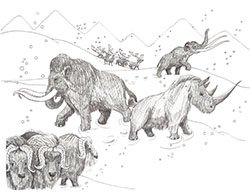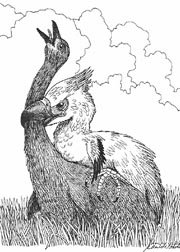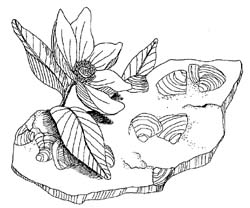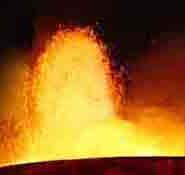Sign up for Lesson Plans, discounts & more!
The Cenozoic Era:
Age of Mammals

The Cenozoic Era is the last and most recent of the geologic eras. Its name means “new life” coming from the Greek root kainos, meaning “new,” and zoic, “life.” While this new life came to refer to mammals-thus coined The Age of Mammals- this new life could have just as easily been the angiosperm or flowering plants, the insects, the newest fish (teleostei) or modern birds. All of these groups, including the mammals, continued to evolve during this present Era.
The Rise of The Mammals

During the Cenozoic, mammals evolved from their somewhat insignificant stature during the Mesozoic to include giant species that have gone extinct in modern times. While none of the mammals ever reached the size of the dinosaurs, there were some species that dwarfed their modern-day relatives. Everyone knows about mammoths, but during the Cenozoic Era some birds stood 7-feet tall. There were beavers 7 feet long! These creatures were typical of the growth achieved by the “new life” in the early Cenozoic.
The continents mostly existed more or less as we know them. At the beginning of the Cenozoic South America, Africa, and India were not yet in the places they are today. All three of these land masses were moving north and would collide with North America, Europe, and Asia respectively. The collisions of Africa and especially India led to mountain building resulting in the Alps and the Himalayan mountain ranges.
The global climate was very warm at the beginning of the Cenozoic gradually cooling and becoming drier closer to the end of the era. Grasslands became more widespread making habitat for grazing animals like buffalo, horses, camels and others. Nearer the present the Earth entered an Ice age.

Check out some of the Educational Materials for sale on our sister site fossilicious.com.

Flowering Plants
Flowering plants or angiosperms were became widespread in the Cenozoic Era. They moved into niches all over the globe. Trees, grasses, shrubs and everything in between, angiosperms came to dominate many of the earth's biomes. This was beneficial to insects, many of
which evolved symbiotic relationships with flowering plants.
The
Cenozoic includes the period that began roughly 65 million years ago to
the present. Historically, the Era has been divided into two periods:
the Tertiary and the Quaternary.
These terms came from the 19th century when rock formation in Europe
was classified as primary (being the oldest), secondary and tertiary,
with quaternary being coined slightly later. As more sophisticated
geologic understanding evolved, primary and secondary were dropped from
use. Only Tertiary and Quaternary remained as the divisions of the era.
Changes In The Naming System
But these divisions don’t seem
appropriate in the light of current understanding about the geologic
changes that occurred during the Cenozoic. New terms are being used that
relate more closely and accurately to the stratigraphy of the planet: Paleogene for the early part of the Cenozoic including the early two-thirds of the Tertiary Period, and Neogene
for the last part of the Tertiary and the Quaternary. Suffice it to
say, regardless of what it is called, the geology that occurred remains
the same!
But let us not forget that the Cenozoic Era is a geologic classification and get back to the geology that distinguishes this period.
The Continents Move
During this time, the
continents continued the separation that had begun at the end of the
Mesozoic Era during the Cretaceous Period. The Atlantic Rift was
widening and forcing more continental separation, in particular
Greenland from Europe. Other ocean spreading rifts caused the separation
of Australia from Antarctica and Africa from India. The supercontinents
of Gondwanaland and Laurasia that had been the result of tectonic
movement during the Mesozoic, were now transforming into the continents
of modern day.

Volcanic Activity Builds Mountains
The rifts that occurred around the globe resulted in volcanic activity that formed mountain ranges. The Cascade Range that extends along the coast of North America from British Columbia to California is one example of this rifting/volcanic activity. Volcanic activity in Europe, Asia and Africa resulted in the formation of the Himalayan and Alpine mountain systems.
The Cenozoic Era: Time Marches On
And so the Cenozoic era continues. It is the era we live in, though we could hardly say this is the era of humans. We have been present as a species only about 1.5 million years of the 65 million years of the current era. That represents about 7 seconds on the clock of eras!
interested in more? If so, you may want to check out our other sites:
fossilicious.com - Our online fossil and mineral rock shop.
rocksandminerals4u.com - An educational site about rocks, minerals, and geology.
Geologic Time Geologic Time Line
Cenozoic Era
Quaternary
Neogene
Paleogene
Mesozoic Era
Cretaceous
Jurassic
Triassic
Paleozoic Era
Permian
Carboniferous
Devonian
Silurian
Ordovician
Cambrian
Archean Time
Hadean Time
Teachers Resources
Activities for Education and Fun
Earth Science Lesson Plans
Activities For Kids
Fossil Lesson Plans
Fossil Activities
Education Articles
Coloring Pages
Dinosaur Coloring Pages
Montessori Materials
Geology Club
Fossil Hunting
 |
 |
 |




